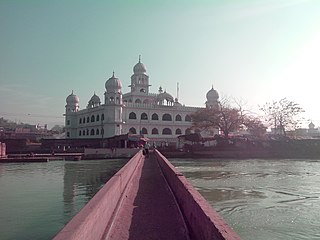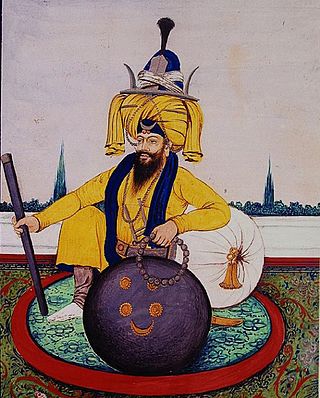
Guru Gobind Singh was the tenth and last human Sikh Guru. He was a warrior, poet, and philosopher. In 1675, at the age of nine he was formally installed as the leader of the Sikhs after his father Guru Tegh Bahadur was executed by Emperor Aurangzeb. His father was the ninth Sikh Guru. His four biological sons died during his lifetime – two in battle and two executed by the Mughal governor Wazir Khan.

Guru Tegh Bahadur was the ninth of ten gurus who founded the Sikh religion and was the leader of Sikhs from 1665 until his beheading in 1675. He was born in Amritsar, Punjab, India in 1621 and was the youngest son of Guru Hargobind, the sixth Sikh guru. Considered a principled and fearless warrior, he was a learned spiritual scholar and a poet whose 115 hymns are included in the Guru Granth Sahib, which is the main text of Sikhism.
The following outline is provides an overview of Sikhism, or Sikhi.

Anandpur Sahib, also referred simply as Anandpur, is a city in Rupnagar district (Ropar), on the edge of Shivalik Hills, in the Indian state of Punjab. Located near the Sutlej River, the city is one of the most sacred religious places in Sikhism, being the place where the last two Sikh Gurus, Guru Tegh Bahadur and Guru Gobind Singh, lived. It is also the place where Guru Gobind Singh founded the Khalsa Panth in 1699. The city is home to Takhat Sri Kesgarh Sahib, the third of the five Takhts in Sikhism.

Panj Pyare refers to a gathered ad hoc quintet of five baptised (Amritdhari) Khalsa Sikhs who act as institutionalized leaders for the wider Sikh community.

Kesgarh Qila or Takht Kesgarh Sahib, alternatively spelt as Keshgarh Qila, is one of the five takhts of the Sikhs located in Anandpur Sahib in Rupnagar district of Punjab, India. It is located just 40 km from Rupnagar city, the district headquarters and 78 km from state capital Chandigarh. The fort is also called Takhat Keshgarh Sahib. This Gurdwara was one of the forts constructed by Guru Gobind Singh at Anandpur Sahib for the defense of the Sikhs. He spent his 25 years at Anandpur Sahib and, to protect the Sikhs from the Rajas of the Hill States and Mughals, began the construction of five defensive Qilas (forts) all around the town.

Bhai Mani Singh was an 18th-century Sikh scholar and martyr. He was a childhood companion of Guru Gobind Singh and took the vows of Sikhism when the Guru inaugurated the Khalsa in March 1699. Soon after that, the Guru sent him to Amritsar to take charge of Harmandir Sahib, which had been without a custodian since 1696. He took control and steered the course of Sikh destiny at a critical stage in Sikh history. He was also a teacher of the Gianian Bunga, later becoming known as the "Amritsari Taksal", currently located in Sato Ki Gali.

Mata Gujri, also spelt as Mata Gujari, was the wife of Guru Tegh Bahadur, the ninth Guru of Sikhism, and the mother of Guru Gobind Singh, the tenth Guru of Sikhism. She played a central role in the history of Sikhism and is one of the four consorts bestowed with the title of Guru-Mahal.

Bhai Dayala, also known as Bhai Dayal Das, was an early martyr of Sikhism. He was boiled alongside his Sikh companions Bhai Mati Das and Bhai Sati Das and the Ninth Guru, Guru Tegh Bahadur.
Sodhi is a clan of Khatris and Jatts originated from the Indian Punjab.

Bhai Sati Das along with his elder brother Bhai Mati Das were martyrs of early Sikh history. Bhai Sati Das, Bhai Mati Das and Bhai Dyal Das were all executed at kotwali (police-station) in the Chandni Chowk area of Delhi, under the express orders of emperor Aurangzeb just prior to the martyrdom of Guru Tegh Bahadur. Bhai Sati Das was executed by the means of being wrapped in cotton wool soaked in oil and set on fire.
The Battle of Bhangani was fought between Guru Gobind Singh's army and Bhim Chand (Kahlur) of Bilaspur on 18 September 1686 or 1688, at Bhangani near Paonta Sahib. An alliance of Rajput Rajas of the Shivalik Hills participated in the engagement on behalf of Bhim Chand of Bilaspur State's side, including the states of Garhwal and Kangra. It was the first battle Guru Gobind Singh, the tenth Sikh Guru, fought at the age of 19.

Baba Jiwan Singh was a Sikh general and companion of Guru Gobind Singh.

Kiratpur, also known as Kiratpur Sahib, is a town, just 30 km from Rupnagar city in Rupnagar district of Punjab, India. The town is the location of the Gurdwara Patal Puri where many Sikhs take ashes of their deceased.

Baba Darbara Singh, also known as Diwan Darbara Singh, was second Jathedar of Budha Dal and third leader of the Akal Takht. He should not be confused with other Darbara Singh of Sirhind who fought in the Battle of Anandpur.
The first siege of Anandpur was a thirty-five-day-long siege at Anandpur led by the Rajas of the Sivalik Hills and the Gujar and Ranghar tribesmen against the armies of the Sikh under Guru Gobind Singh.

The Akāl Sena was the Sikh military force established by the sixth Sikh Guru, Guru Hargobind. It was the first standing Sikh army. It was also known as the Akali Dal.
The Battle of Anandpur was fought by the Sikh forces led by Guru Gobind Singh and the Kahlur forces led by Bhim Chand. This was also the first battle fought by Guru Gobind Singh.
The Battle of Anandpur (1685) was fought between the Sikhs and an allied force of rajas of the Hill States of the Sivalik range, specifically Kahlur, Kangra, and Guler.

Kavi Darbar is a term that refers to historical Sikh durbars (courts) composed of congregations of poets, litterateurs, artists, and scholars that were established and had flourished during the guruship period of Guru Gobind Singh in the late 17th and early 18th centuries. These establishments served as Sikh centres of learning and scholarship. They played a pivotal role in the history of Sikh literature.














